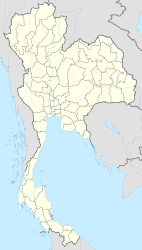Ban Chiang
|
บ้าน เชียง Ban Chiang |
||
|---|---|---|
|
|
||
| Coordinates | 17 ° 22 ′ N , 103 ° 13 ′ E | |
| Basic data | ||
| Country | Thailand | |
| Udon Thani | ||
| ISO 3166-2 | TH-41 | |
| Residents | 3,000 (2000) | |
Ban Chiang ( Thai : บ้าน เชียง ) is a town in northeastern Thailand . It is located in the district of Nong Han of Udon Thani province .
location
Ban Chiang is about 50 kilometers east of the provincial capital Udon Thani on the border with Sakon Nakhon province .
Economy and Importance
In the past, the people here lived rather poorly on the meager harvests of the rice fields and plantations in the area. Now tourism is Ban Chiang's main source of income, drawn to the sensational Bronze Age finds.
history
Until 1967 it was assumed that Ban Chiang - like most other villages and towns in the area - had been settled from Laos around 1820 . And since then there have been reports and testimonies of finds: bones, ceramics, metal tools, etc.
In 1966 the American Steve Young (son of the then American ambassador to Thailand) made the archaeologists in Bangkok aware of the site. Sensational finds came to light in two campaigns (1966–1967 and 1972), which initially indicated that the area was already in the middle of the 4th millennium BC. Chr. Was populated and home to a highly developed agricultural culture. Sufficient organic material for radiocarbon dating could only be obtained during later excavations , which means that the beginnings of Ban Chiang at the end of the 3rd millennium BC. Chr. Were newly dating.
Fine ceramics with spiral and ribbon ornaments, stylized plants and animals and natural clay pots with elegant shapes and imaginative patterns (e.g. wave patterns, leaves, thumb prints) were discovered. They are among the oldest ceramic patterns on earth. The excavation received the greatest attention, however, due to the Bronze Age tools, which are unique in Southeast Asia. If the original dating had been confirmed, then the Bronze Age would have started here at the time of the European Neolithic (parallel to the development in Mesopotamia ). The similarity of the patterns and colors between the finds in Ban Chiang and those in Mesopotamia is amazing.
According to various studies, the Bronze Age began in Ban Chiang towards the beginning or end of the 2nd millennium BC. BC, the copper processed in Ban Chiang came from the highlands of Laos . The Iron Age began around the 7th century BC. The settlement was finally abandoned around 300 AD.
In 1992, Ban Chiang was recognized as a World Heritage Site by UNESCO .
See also : History of Thailand .
Attractions
- Ban Chiang National Museum - excavation pieces are on display (with explanations in English) with dioramas depicting excavation and past life, and an original site is located nearby
literature
- Elizabeth E. Broadrup: Ban Chiang (Udon Thani, Thailand) (= Paul E. Schellinger, Robert M. Salkin [Eds.]: International Dictionary of Historic Places . Vol. 5 - Asia and Oceania). 1996, p. 82–86 (English, limited preview in Google Book Search [accessed February 14, 2019]).
- C. Higham, T. Higham, R. Ciarla et al .: The Origins of the Bronze Age of Southeast Asia . In: J World Prehist . tape 24 , no. 4 , December 2011, p. 227–274 , doi : 10.1007 / s10963-011-9054-6 ( ResearchGate [accessed February 14, 2019]).
- CFW Higham, K. Douka, TFG Higham: A New Chronology for the Bronze Age of Northeastern Thailand and Its Implications for Southeast Asian Prehistory . In: PLoS ONE . tape 10 , no. 9 , September 2015, p. 1-20 , doi : 10.1371 / journal.pone.0137542 .
- The PLOS ONE Staff: Correction: A New Chronology for the Bronze Age of Northeastern Thailand and Its Implications for Southeast Asian Prehistory . In: PLoS ONE . tape 10 , no. 11 , November 2015, p. 1-2 , doi : 10.1371 / journal.pone.0142511 .
Web links
- Map of the Udon Thai Province (names in Thai and English - last accessed November 29, 2015)
- http://www.udonthani.com/english/ Information, directions (from Udon Thani)
- Entry on the UNESCO World Heritage Center website ( English and French ).




